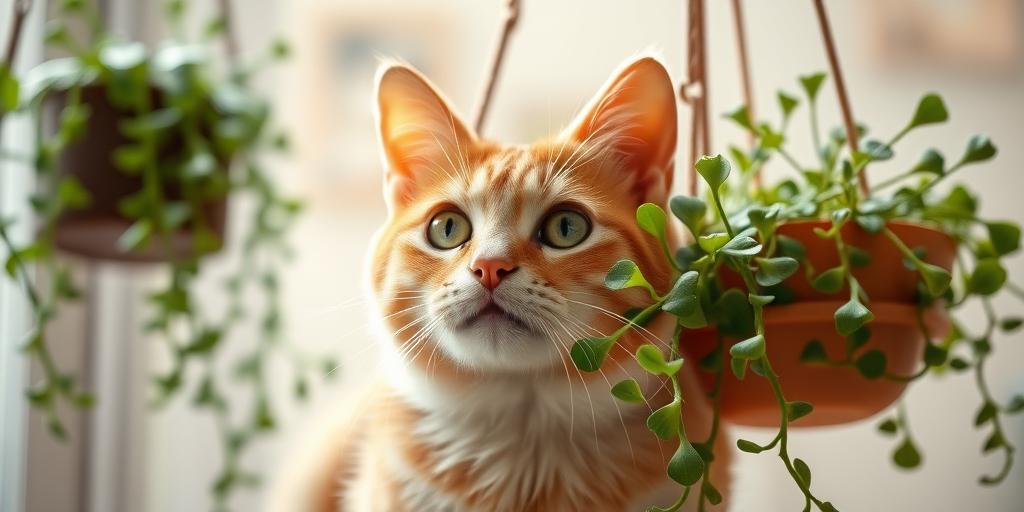
5 Cat-Friendly Low Light Hanging Plants for a Pet-Safe Home
Looking for cat-friendly low light hanging plants? Discover 5 safe, easy-care options that thrive in dim spaces while keeping your curious feline happy and healthy!
Introduction
Did you know that over 30% of pet owners avoid houseplants due to toxicity concerns? If you’re a cat parent with a less-than-sunny home, finding the right hanging plants can be tricky. But don’t worry—there are plenty of beautiful, non-toxic options that thrive in low light! In this guide, we’ll explore 5 cat-friendly hanging plants that are safe for your furry friend and perfect for spaces with minimal sunlight. Whether you’re a seasoned plant parent or a beginner, these picks will add greenery to your home without the stress. Let’s dive in!
Spider Plant (Chlorophytum comosum)
If you’re looking for a cat-friendly plant that’s nearly impossible to kill, the spider plant is a top contender. Not only is it completely non-toxic to cats, but it also acts as a natural air purifier, removing common household toxins like formaldehyde and xylene.
Light Requirements
Spider plants are incredibly adaptable when it comes to lighting. They thrive in bright, indirect light but can also tolerate low-light conditions, making them perfect for apartments or rooms with limited sunlight. Just avoid direct, harsh sun, which can scorch their leaves.
Care Tips
One of the best things about spider plants is their resilience. They don’t need constant attention—water them moderately, allowing the soil to dry out slightly between waterings. Overwatering can lead to root rot, so when in doubt, wait a day or two before giving them another drink.
Bonus Feature
Spider plants produce tiny offshoots called “pups,” which dangle from the mother plant on long stems. These can be easily snipped off and propagated in water or soil, giving you endless new plants to share or expand your indoor jungle.
Boston Fern (Nephrolepis exaltata)
For a lush, tropical feel that’s safe for curious cats, the Boston fern is an excellent choice. Its feathery fronds add texture and movement to any space, and unlike many ferns, it’s non-toxic to pets.
Light Requirements
Boston ferns prefer filtered or low light, making them ideal for bathrooms or shaded corners. Too much direct sunlight can cause their delicate leaves to brown and dry out.
Care Tips
These ferns love humidity, so if your home is dry, mist them regularly or place them near a humidifier. Keep the soil consistently moist but not soggy—letting it dry out completely can cause the fronds to drop.
Bonus Feature
Beyond being pet-safe, Boston ferns are natural air purifiers, helping to remove pollutants like formaldehyde and xylene from your home.
Staghorn Fern (Platycerium bifurcatum)
If you want something truly unique and cat-safe, the staghorn fern is a fantastic option. Its antler-like fronds make it a striking statement piece, and it’s completely non-toxic to pets.
Light Requirements
Staghorn ferns do well in bright, indirect light but can also tolerate lower light conditions. Avoid direct sun, which can scorch their leaves.
Care Tips
Unlike most plants, staghorn ferns don’t need traditional potting soil. They’re epiphytes, meaning they naturally grow on trees, so mounting them on a wooden plaque or hanging them in a basket mimics their natural habitat. Water them by soaking the roots when the base feels dry.
Bonus Feature
Because they don’t require soil, staghorn ferns are perfect for creative displays—think mounted on driftwood or hung as living wall art.
Peperomia (Peperomia spp.)
Peperomias are a diverse group of small, pet-safe plants with a wide variety of leaf shapes and textures, from ripple-edged to succulent-like. Their compact size makes them perfect for shelves, desks, or small spaces.
Light Requirements
These plants adapt well to low to moderate light, though they’ll grow best with bright, indirect sunlight. Too much direct sun can fade their vibrant foliage.
Care Tips
Peperomias prefer well-draining soil and should be watered sparingly—overwatering is their biggest enemy. Let the top inch of soil dry out before giving them a drink.
Bonus Feature
Their slow, compact growth means they won’t outgrow their space quickly, making them ideal for terrariums or mixed plant arrangements.
Swedish Ivy (Plectranthus verticillatus)
For a fast-growing, trailing plant that’s safe for cats, Swedish ivy is a great pick. Its rounded, glossy leaves cascade beautifully, making it perfect for hanging baskets or high shelves where it can spill over the edges.
Light Requirements
Swedish ivy thrives in low to bright indirect light. While it can tolerate lower light, it grows more vigorously with brighter conditions (just avoid direct sun, which can scorch the leaves).
Care Tips
Keep the soil consistently moist but not waterlogged. Pinching back the stems encourages bushier growth and prevents the plant from becoming leggy.
Bonus Feature
This plant grows quickly, so if you love the look of trailing greenery, Swedish ivy will give you lush results in no time. Plus, it’s easy to propagate—just snip a stem and place it in water to root.
Conclusion
Adding greenery to your home doesn’t have to be risky for your cat or limited by low light! These 5 cat-friendly hanging plants are safe, easy to care for, and perfect for dimmer spaces. Whether you choose the hardy Spider Plant or the elegant Boston Fern, you can enjoy lush foliage without worry. Ready to transform your space? Pick your favorite from this list and start hanging! And if you’ve already tried any of these, let us know in the comments how they’ve worked for you and your feline friend. Happy planting! 🌿🐱
